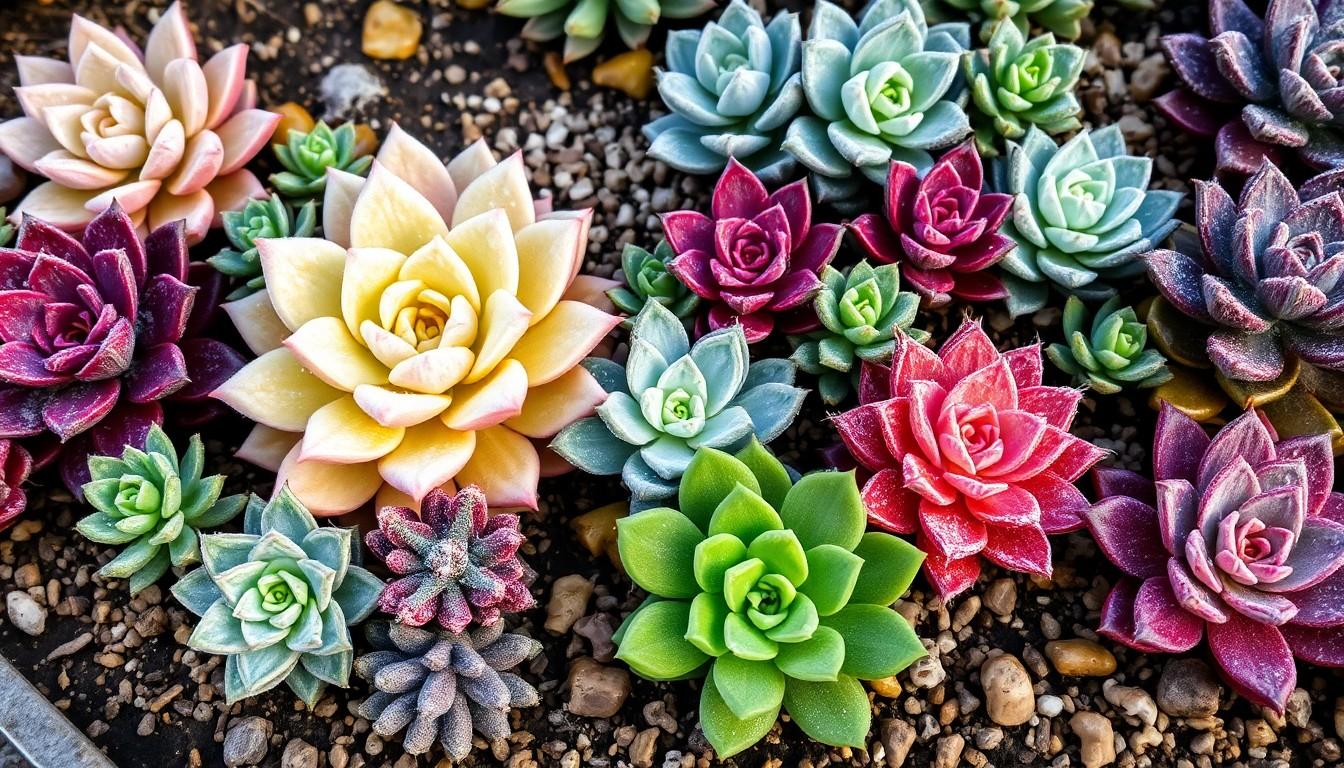When it comes to succulents, most people think of sunny deserts and warm climates. But what happens when the temperature drops and winter comes knocking? Can these resilient little plants handle the chill, or do they need a cozy sweater and a cup of hot cocoa?
Understanding Succulents
Succulents represent a diverse group of plants known for their fleshy leaves and stems. These adaptations enable them to store water, allowing survival in arid environments.
What Are Succulents?
Succulents include various species such as aloe vera, jade plants, and cacti. Their unique characteristics make them popular among gardeners. These plants thrive in dry conditions, utilizing water storage to flourish. They often exhibit vibrant colors and unusual shapes, attracting many enthusiasts. Native habitats vary, incorporating deserts, mountains, and coastal regions.
Importance of Temperature Control
Temperature control plays a vital role in succulent health. These plants prefer temperatures ranging from 60°F to 80°F. Exposure to extreme cold can cause damage, leading to cell rupture and tissue breakdown. Maintaining appropriate conditions fosters growth and prevents stress. When temperatures drop, specific care strategies can enhance survival rates. Protecting succulents during cold months often ensures optimum conditions for thriving.
Cold Hardiness of Succulents

Succulents exhibit varying degrees of cold tolerance, which is influenced by several factors. Knowledge about these factors helps in their care during colder months.
Factors Affecting Cold Tolerance
Species type significantly impacts cold tolerance. Some succulents, like Agave and Echeveria, can endure temperatures below freezing, while others, such as Aloe, struggle. Plant maturity also plays a role; younger plants are more susceptible to cold damage. Additionally, soil and drainage affect cold hardiness. Well-draining soil prevents water accumulation that can harm roots during frost. Microclimates within gardens offer protection; positioning succulents against walls or under shelters increases their chances against cold exposure.
General Temperature Ranges
Most succulents thrive in temperatures ranging from 60°F to 80°F. Many species tolerate light frost, typically down to 30°F, but prolonged exposure can cause harm. Some hardy varieties can withstand temperatures as low as 20°F. Observing the specific needs for each succulent type ensures proper care. Indoor conditions provide a controlled environment, making it easier to maintain warmth. Understanding temperature sensitivity promotes healthy growth in these resilient plants.
Identifying Cold-Tolerant Succulents
Identifying cold-tolerant succulents helps gardeners choose plants suitable for lower temperatures. These varieties exhibit remarkable resilience in frigid conditions.
Popular Cold-Hardy Varieties
Several succulents thrive in cold environments. Agave and Echeveria rank among the most popular, enduring temperatures below freezing. Sempervivum, or houseleeks, showcase excellent cold tolerance and grow well in USDA zones 3 to 8. Additionally, Sedum species, such as Sedum spurium, withstand frost and are easy to care for. Each of these varieties contributes to a vibrant garden even during winter months.
Characteristics of Resilient Succulents
Resilient succulents often share defining traits. Thick, fleshy leaves store moisture, allowing them to survive harsh conditions. A shallow root system promotes drainage, essential for avoiding root rot during frost. Tough exteriors protect against cold damage, while some species develop a natural waxy coating. Color variations in leaves may signal cold adaptation, with darker pigmentation providing extra warmth resistance. These characteristics ensure their survival and thriving presence through colder seasons.
Protecting Succulents from Cold
Cold temperatures pose risks to succulents. Implementing protective measures ensures their health during winter.
Strategies for Cold Protection
Moving succulents indoors during freezing nights maintains safe temperatures. Creating a temporary greenhouse using plastic covers offers additional warmth. Providing mulch around the base helps insulate the soil. Grouping plants together generates heat through their shared microclimate. Utilizing heat mats can elevate soil temperature, reassuring root health. Choose pots with good drainage to prevent root rot from frost. Placing them in sheltered areas can reduce exposure to harsh winds. These strategies significantly enhance cold tolerance, benefiting plant survival.
Signs of Cold Damage
Cold damage manifests through distinct symptoms. Wilting leaves indicate loss of cell structure from freezing temperatures. Discoloration, such as browning or blackening, reflects significant stress. The appearance of mushy stems shows rot, often a result of frost damage. Moreover, stunted growth may signal underlying health issues. Observing these signs early allows for appropriate intervention. Protecting the plants with suitable strategies helps minimize these effects, ensuring thriving succulents in changing conditions.
Conclusion
Understanding how cold succulents can tolerate is essential for any gardener aiming to maintain a thriving collection. While many succulents exhibit impressive resilience against lower temperatures, their survival often hinges on specific care strategies and environmental factors.
Choosing the right cold-hardy varieties and implementing protective measures can significantly enhance their chances of thriving through winter. By paying attention to signs of cold stress and acting promptly, gardeners can ensure their succulents not only survive but flourish in the colder months. With the right knowledge and practices, these remarkable plants can continue to bring beauty and vibrancy to gardens year-round.

